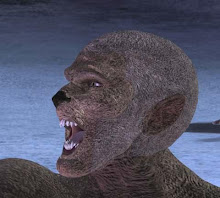National Geographic Channel - Original Air Date: 2005-6
The story of the mysterious "goat sucker" -- el chupacabras -- begins in Puerto Rico, which in 1995 experienced a number of "mysterious" livestock death. The media dubbed the culprit el chupacabras, and at the height of the phenomenon, 200 people combed the land each night hunting the creature. As local vets began necropsies, the sightings began -- a strange green creature with spines down its back, wings, and glowing red eyes. Soon, hundreds of people, unsatisfied by the explanation of natural predation, report sightings and begin forming their own investigation networks. Conspiracies abound: alien? Alien Pet? Government experiment gone wrong? But the research group theories lack any actual proof -- like many other myths. A skeptic points out that the chupacabras is like answering a riddle with a riddle: What's killing the animals? Chupacabras. What's a chupacabras? We don't know. Three hundred animal autopsies show nothing unnatural, but the legend spreads to other countries, including the US. The show points out parallels between the spread of the chupacabras legend and the European legend of the vampire. The fact that chupacabras seemed to spread among Spanish-speaking areas suggests a cultural connection rather than a supernatural one. Soon, physical evidence: footprint casts and, eventually, bones. And while this is being looked into, a new question arises: is the chupacabras responsible for US cattle mutilations? One vet declares that either there's a UFO/chupacabras thing going on, or some kind of cult is doing the "mutilations." Skeptics remain unconvinced, and they have a landmark experiment to back them up. Herb Marshall, a retired Arkansas sheriff, looked into the "mutilations" years ago -- by setting a trap for the culprits. After a series of "mutilations" in 1979, he left a fresh carcass in a field and staked it out too see what would happen. Then, they watched, working in shifts, and recorded what they saw. They didn't find the expected buzzards, but the did find blow flies, which quickly stripped bloated organs with precision that rivaled wounds from surgery. Within 48 hours, they had a typical "mutilation" corpse. A vet confirms that such processes and natural scavengers -- flies, coyotes, buzzards -- can cause all the typical hallmarks of the chupacabras. But what about those prints and chupacabras bones? A Museum of Natural History scientist declares the prints to be "too good to be true," showing signs of being faked. Scientists at the University of Nicaragua discover the supposed chupacabras carcass is actually that of a domestic dog. Their conclusions drew anger from believers, and even threats. Skeptics theorize that blaming an unknown animal makes harried farmers feel less personally responsible for loss of livestock. But the 300 autopsies support the natural predator theory, showing signs of attack by such creatures as monkeys and large cats. Eyewitness descriptions differ, too -- as if each witness is seeing something different. Seeing may be believing, but believing is apparently also believing. As of this show's production, there is no reliable scientific evidence supporting the existence of the chupacabras.
Thursday, May 29, 2008
Subscribe to:
Post Comments (Atom)





No comments:
Post a Comment